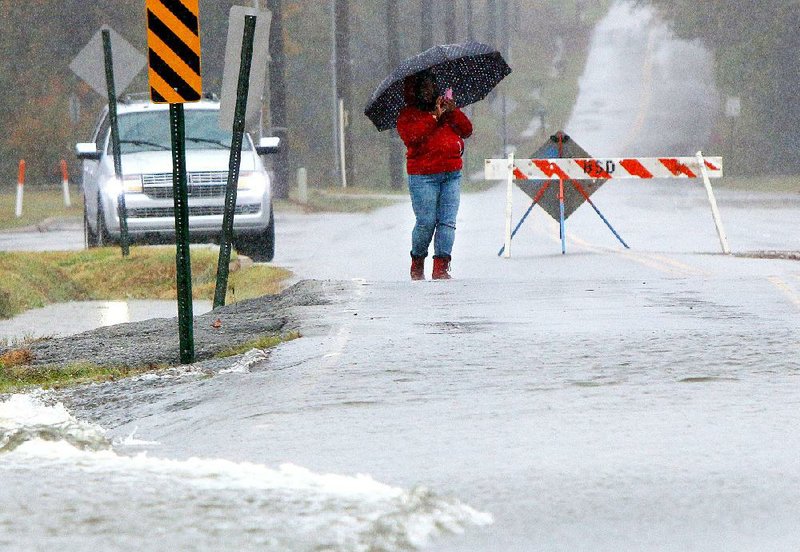Rain flooded parts of western Arkansas and several rivers across the state Saturday, but the clouds are expected to drop much less rain today and Monday.
The highest rain totals expected in the state today are about 1 to 2 inches in southeast Arkansas, said meteorologist Brian Smith of the National Weather Service in North Little Rock.
On Saturday, rain caused a few hazards in the state. A half-mile of Arkansas 166 near Stokes closed because of high water, according to the Arkansas Highway and Transportation Department, and the Bryant Police Department closed Boone Road at Bishop Park because of flooding.
The road closure in Bryant is the only one meteorologist Michael Brown said the weather service in North Little Rock was aware of Saturday afternoon.
Water levels rose at Lake Hamilton in Garland, Entergy Arkansas spokesman Julie Munsell said, causing some docks to break loose, which would cause problems for owners with boats docked there.
Munsell said he wasn't aware of any major blackouts related to the rain, although some parts of the state experienced minor power failures.
After more than 3 inches of rain saturated the ground in western Arkansas about two weeks ago, meteorologist Glenn Wiley said, the 1 to 3 inches that dropped this weekend turned into runoff, causing floods.
"During the summertime, it wouldn't be any problem at all," said Wiley, who works with the National Weather Service in Tulsa. "Everything is green ... soaks it right up."
But in the winter, the same amount of rain turns into runoff.
"It's not so much the amount of rainfall you get but the amount of runoff you get that causes floods," Wiley said.
Western Arkansas won't get much rain today, Wiley said. Northwest Arkansas should get about one-third of an inch. Areas to the south and east of Fort Smith will get about three-quarters of an inch to an inch.
"The good news is that things are tapering off," Wiley said.
Flood warnings were issued Saturday for Northwest Arkansas down to Sebastian County. The warning for the northwest corner of the state was removed by midday Saturday, and meteorologist Joe Sellers in Tulsa said the warning for Sebastian, Franklin and southern Crawford counties would be lifted at 11:15 a.m. today.
Several flood warnings also were issued along rivers in the state, including the White River at Augusta, Cache River at Patterson, Petit Jean River at Danville, Black River at both Black Rock and Pocahontas, and Saline River at Benton.
"Some of the rivers will crest and start to fall in the next few days," Smith said.
"The White River, particularly Augusta and below, and the Cache River will probably remain high at least into [this] week, maybe longer," Smith said, because of significant rainfall upstream in Northwest Arkansas.
The U.S. Army Corps of Engineers issued a small-craft advisory for the Arkansas River on Saturday because "recent heavy rains caused flows to rise," according to a news release from the agency.
Such warnings against taking out small boats for fun are issued when river flows exceed 70,000 cubic feet per second, the release stated. Dams in Fort Smith and Russellville measured flows of 120,000 and 140,000 cubic feet per second, while dams at Little Rock and Pine Bluff measured flows of 80,000 and 70,000 cubic feet per second, the agency said.
In the 72 hours before midday Saturday, 7 to 9 inches of rain fell in the area of the Ouachita Mountains, Smith said.
A gauge in Nunley measured 9.07 inches of rain, and gauges in Caddo Gap, Big Fork and Langley all measured more than 7 inches, Smith said.
In west Little Rock, rain was measured at 6 to 7 inches, although a bit farther south in western Saline County, gauges measured just more than 4 inches.
A gauge at Adams Field in Little Rock measured just more than 4 inches, Smith said, and farther south in Sheridan and Sparkman, 1 to 2 inches had fallen in the previous 72 hours.
Little Rock had received 2.85 inches of rain Saturday as of 4 p.m., the National Weather Service reported.
The weather service said that raised the city's year-to-date total to 51.72 inches. With 9.93 inches for the month by Saturday afternoon, Little Rock was at its sixth-wettest November on record. The record, which Brown said could be broken this weekend, is 10.2 inches of rain.
North Little Rock received 2.7 inches Saturday as of 4 p.m., raising its yearly total to 55.78, the weather service said.
Information for this article was contributed by staff members of The Associated Press.
Metro on 11/29/2015
